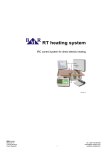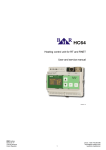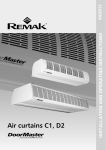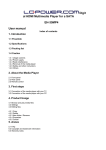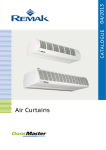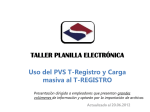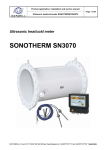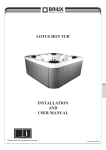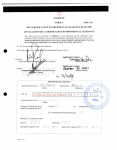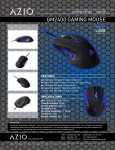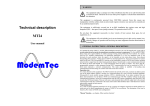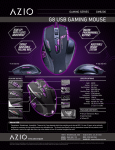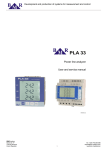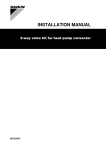Download RNET heating system
Transcript
RNET heating system IRC control system for hot-water heating version 1.5 Development and production of systems for measurement and control Content 1. General introduction and description....................................3 2.3.6. SJ64-8 switching module....................................9 2. Description...........................................................................4 3. The design and installation of the control system..............10 2.1. Description of parts......................................................4 4. Technical features...............................................................11 2.2. Main elements.............................................................5 5. Communication features of HC64_SZ................................12 2.2.1. Control unit HC64...............................................5 5.1. USB connection.........................................................12 2.2.2. Room sensors.....................................................5 5.2. Ethernet connection...................................................12 2.2.3. Actuator TSH24V................................................6 5.2.1. Web server........................................................12 2.2.4. Power supply unit SZ24V....................................6 5.2.2. Modbus TCP.....................................................12 2.3. Optional accessories...................................................7 5.2.3. Operation via the Internet.................................12 2.3.1. End item KC64_NET...........................................7 6. Connection diagram...........................................................14 2.3.2. LOW modem.......................................................8 7. Installation examples..........................................................15 2.3.3. Window contact...................................................8 7.1. Building with radiator heaters....................................15 2.3.4. Virtual sensor......................................................9 8. Sensor address ID setting..................................................17 2.3.5. SJ64-1 switching module....................................9 BMR trading Horní lán 17 779 00 Olomouc Czech Republic 2 phone: +420 778 066 566 [email protected] www.bmr-trading.com Development and production of systems for measurement and control 1. General introduction and description Solving of the regulation system design can be divided into two parts: • Heating source control. • Heating control for particular rooms. System is based on so called IRC (Individual Room Control) regulation. IRC is temperature control in every room according to time table set by user. This installation manual provides information about IRC system design and installation. BMR offers two IRC regulation systems: • RNET regulation system. It is programmable control system for heating regulation of buildings with hot-water radiators or floor and block storage heaters. In the maximal configuration it can contain 16 control section where every control section controls up to 32 regulators. Whole system is able regulate temperature in 512 rooms. • RT regulation system. It is programmable control system for heating regulation of buildings with direct electric convectors, heating mattings and foils. In the maximal configuration it can contain 16 control section where every control section controls up to 32 regulators. Whole system is able regulate temperature in 512 rooms. Both systems are principally very similar. Used control station is the same, similar are thermostatic room sensors and optional control software for PC. Systems are different only in control of heating source. For hot-water system RNET, thermostatic sensors control thermo-drives on the radiators in the rooms, eventually ventilator for electric storage radiator. RT system controls electric heating convectors or mattings by auxiliary power control unit. For switching of convectors or matting, semiconductor switchers are used. Both systems can be combined together. Main advantages: • efficiency – up to 30 % energy saved • comfort – heating is controlled absolutely automatically including the time changes summer/winter time • easy setting and operation • high reliability and working life. First installations are in the operation for more than 19 years • 36 months warranty • possibility to connect controllers into a system for large objects heating • possibility to set and control system remotely by PC or any device with web browser Great advantage of regulation systems RT and RNET is the method of the object heating control. Temperature in every room can be programmed independently on the rest of the object. Mode can be the same for whole week or different for every day in the week. Temperature is possible be changed eight times per day in the mode. Room heating program for whole object can be turned to the low consumption mode (LOW program) manually or it can be set by day and time. Normal mode is restored by the same way. This feature is very useful for longer planned absence from building. For example when the family is leaving for the holiday and returning back to the comfortable heated house while the house was kept on the low temperature during their absence. Whole regulation system is modular and it is possible and easy to design it on the customer request and heating system structure. BMR trading Horní lán 17 779 00 Olomouc Czech Republic 3 phone: +420 778 066 566 [email protected] www.bmr-trading.com Development and production of systems for measurement and control 2. Description RNET regulators can control heating at hot-water systems with radiators and also with heated floor. System RNET for hotwater system creates communication network, which connects all system components through. Indoor thermostatic sensors for RNET system are not only passive temperature sensors, but they are based on intelligent microprocessor control, which provides data and commands exchange with control section. This type of sensors is called digital. Every single element of the system is identified by unique address defined by switches on the sensor. Other special devices, for example end item, are identified by unique address defined by producer. Within the regulation system RNET, every thermostatic sensor is counted as one control channel of the system. One control unit can operate with maximum of 32 thermostatic sensors. One programmable thermostatic sensor can control up to 10 actuators TSH24V. This feature is very useful for schools, conference rooms, hospitals, etc. 2.1. Description of parts Regulation system is based on elements, which can be defined as two following groups: • Main elements. Basic elements are necessary for every regulator and neither one can be left out. Basis for the system is control unit with power supply unit, programmable thermostat sensors and actuators. • Additional elements. Additional elements increase comfort and improve some features of regulation system. However their usage is not essential. In the group of additional elements there can be found: • end-item KC64_NET • window contact OK_NET • LOW modem • switching modules SJ64-1 and SJ64-8 BMR trading Horní lán 17 779 00 Olomouc Czech Republic 4 phone: +420 778 066 566 [email protected] www.bmr-trading.com Development and production of systems for measurement and control 2.2. Main elements 2.2.1. Control unit HC64 Control unit HC64 keeps setting of regulation schedules for up to 32 independent heating circuits. It is possible to set up to 8 different temperature changes in one day, at any time and for any value. Part of the control unit delivery is also power supply 24 VAC / 2.5A. It supplies control unit, thermostatic sensors and actuators operated by sensors. Control unit has two operation modes. User mode, which allows displaying room temperature, defining temperature profile, etc. Service (administrator) mode, protected by password, which is supposed to be used for fundamental setting of heating system, for example number of circuits, communication parameters and temperature calibration for every sensor. More information, operation and setting of HC64 can be found in technical documentation of HC64. Control unit must be placed on common three-wires bus network to the place where the user will make all actions. If the system is equipped by PC, it can be actually placed on any even invisible place. Personal computer can be connected to the control unit via USB or Ethernet interface. 2.2.2. Room sensors Room sensors HTS64 range are in fact real digital thermostats with a built-in temperature sensor, output for direct control of the actuator and input for window contact. HTS64 is an independent device that works as a PI (proportional integration) controller which communicates with the control unit HC64 for to get the information about the targeted temperature in the particular circuit. On the contrary it provides information about the measured temperature and actuator status to control unit. According to a customer specification three types of thermostat can be offered: HTS64 HTS64D Basic type of thermostat. HTS64DN Thermostat with LCD which shows current temperature and actuator status. HTS64DIN Thermostat with LCD and buttons. Display shows current temperature and actuator status. Unit is equipped with buttons for local temperature setting. Locally set temperature is kept until next temperature change according to the regime. Thermostat designed for DIN rail installation with a size of 1 standard module. Module has a terminal for external analogue temperature sensor and one 8A output relay. ID address of the HTS64DIN is set on the board inside the instrument at the factory. Sensors are available in several designs of case in order at to fit the style of the other elements used in the house. Following designs are available. Manufacturer / type HTS64 HTS64D HTS64DN ABB Element ● ● ● ABB Time ● ● ● ABB Tango ● ● ● ABB Neo ● ● ● ABB Neo Tech ● ● ● ABB Swing ● ● ● ABB Classic ● ● ● BMR trading Horní lán 17 779 00 Olomouc Czech Republic 5 phone: +420 778 066 566 [email protected] www.bmr-trading.com Development and production of systems for measurement and control Schneider Unica Basic ● ● ● Schneider Unica Color ● ● ● Schneider Unica Top, Plus ● ● ● Schneider Marten M-Smart ● ● ● Legrand Cariva ● ● ● Legrand Valena ● ● ● Legrand Galea Life ● Important All sensors measure with accuracy 1ºC. This accuracy is absolutely sufficient for measurement of room temperature. Nevertheless sensor can be calibrated on higher accuracy. For heating systems with block storage heaters, their ventilator for 230 V AC is connected via external relay on terminals labeled “valve”. Control voltage relay has to be 24 VDC. If relay is glimmering it is recommended to connect RC element (220 Ω + 470 μF/35V) on terminals of relay control voltage. 2.2.3. Actuator TSH24V Actuator is an unit which either opens or closes hot water inlet to the heater through the valve. Standard system design counts with actuators with control voltage of 24 V DC. One actuator has consumption 33 mA at 24 V. One programmable thermostat (sensor) can control up 10 actuators connected in parallel. Nevertheless total current demand has to be less than 500 mA. Actuator TSH24V is delivered with supply lead of 0.5 m. In case that actuators from other producers are used in the system it is necessary to count with higher drive current, which is passing for 30 seconds. Forgetting this can cause sensor transistor output overloading and damage of sensor. Actuator is designed for valves from: HEIMER, SIEMENS, HONEYWELL, HERZ, LANDYS. It is not possible to directly use sockets from GIACOMINI and DANFOSS. These require reduction set. Actuators for underfloor heaters are designed for 230 VAC control voltage. Important Actuator TSH24V is mechanically blocked in open position. Closing/opening is managed strictly by regulation and cannot be operated manually. It is forbidden to rotate the actuator manually. It can caused damage of actuator and sensor as well. Important Actuator is not able, due to its construction, fully close the valve in case that ambient temperature is lower than 15°C. If full closing of the valve is demanded at lower temperature the other type of actuator has to be chosen. For example it can be pozistor actuator with working ambient temperature range 5°C … 40°C that is controlled via auxiliary relay with own supply unit 24 VDC. 2.2.4. Power supply unit SZ24V Power supply unit 24 VDC / 2.5 A is designed for DIN rail mounting. It is used for supply of control sections, thermostats and actuators. One unit can supply up to 50 pieces of actuators and in case of bigger systems there can be installed more power supply units together. Power supply unit is a part of control unit HC64SZ delivery. BMR trading Horní lán 17 779 00 Olomouc Czech Republic 6 phone: +420 778 066 566 [email protected] www.bmr-trading.com Development and production of systems for measurement and control Important If the power supply unit SZ24V is placed in the cabinet on a side of HC64 control unit, then it has to be on the right side of the HC64 control unit. 2.3. Optional accessories 2.3.1. End item KC64_NET End item KC64_NET is designed to control heat source: boiler or heat pump. If the control section finds out that all actuators are closed, it sends to the end item instruction for heat source shutdown. If at least one of actuator is open, end item gets instruction to start heat source. KC64_NET is very suitable for the regulation systems where the heat source is electric boiler, gas boiler or furnace oil boiler. On the other hand, KC_NET is not suitable for hot-water storage systems and for all systems where at the boiler room level the equithermic regulation or boiler cascade sorting is needed. Equithermic regulation is solved by BMR controller ETR16. End item is connected to the same bus as the rest of system components. In the RNET64 heating system there can be up to 8 end items KC64_NET used for particular heating circuits. Function description: • If the heating system discovers that all heated zones reached target temperature, output relay of KC64_NET disconnect BMR trading Horní lán 17 779 00 Olomouc Czech Republic 7 phone: +420 778 066 566 [email protected] www.bmr-trading.com Development and production of systems for measurement and control and by that gives signal to heating source. • Green LED On indicates supplied KC64_NET module. • In the normal status (some of rooms are heated) the output relay contacts 15 – 16 are closed and yellow LED is On. • If the KC64_NET receives command to disconnect heating source, output relay switch to connect contacts 15 – 18 and yellow LED is Off. Notice KC64_NET response is not immediate. Command to disconnect or connect heating source is performed after regulation cycle finish. According to the size of the RNET64 system the response time can be with several minute delay. 2.3.2. LOW modem LOW_MODEM allows in conjunction with GSM gate or telephone communicator, remotely switching the regulator over, from comfortable heating mode to the saving mode (“LOW” mode) and back. By SMS messages, contact status of GSM gate is controlled. Description of function: • Green LED on indicates module in the operation. • Yellow LED off – terminals No. 4 – 5 closed, control section heats according to set mode. • Yellow LED on – terminals No. 4 – 5 opened since GSM gate gives signal for control section and it switches to the LOW mode. Note Low is connected to the system on the same bus as other items. Once the LOW_MODEM is installed into the system, it is possible to control mode changes only by SMS GSM gate. Manual switching on control section is disabled. For enabling the manual changes of LOW mod, power supply of LOW_MODEM must be disconnected. 2.3.3. Window contact Window contact OK_NET provides information about the window status (open/close) in the controlled room. It is connected directly to the sensor and includes reed contact, which reacts on the closeness of the permanent magnet. Contact itself is mounted on the window frame and magnet is fixed on the window. If the window is open, then programmable thermostat disconnects appropriate circuit over the actuator and set 8ºC as a target temperature in the room. If the room temperature drops below 8ºC, programmable thermostat opens actuators (protection against low temperature in BMR trading Horní lán 17 779 00 Olomouc Czech Republic 8 phone: +420 778 066 566 [email protected] www.bmr-trading.com Development and production of systems for measurement and control the room). 2.3.4. Virtual sensor Digital sensors HTS64 together with the control unit HC64 have special feature that allows to define so called “Virtual sensor”. To the selected HTS64 sensors it is possible by software define virtual sensor with another ID address. This virtual sensor behaves in the system as normal temperature sensor but with the difference that measured temperature is from the mothers sensor. Thanks to this feature is possible by one temperature sensor HTS64 control the radiator in the bathroom and by virtual sensor controls the underfloor heater in bathroom. 2.3.5. SJ64-1 switching module SJ64-1 is a switching module for DIN rail mounting. Module is listening the communication bus commands from selected HTS64 sensor or virtual sensor and switch on/off the heater. Module is connected to the same three wire bus as control unit and digital sensors. It is equipped by output relay contact 230V/16A. If the output contact is connected the yellow LED is on. In the system there can be several SJ64-1 modules with the same ID address. Address changing of the module is described in the appendix. 2.3.6. SJ64-8 switching module Switching module SJ64-8 is very the same as SJ64-1 but with 8 relay outputs 230V/5A. Typical usage of SJ64-8 is for underfloor heating actuators control in distributor board. Operation status of an outputs is signalized by LED. In the RNET system there can be up to 4 SJ64-8 modules installed. Each output has a unique address related to the HTS64 sensor or virtual sensor. The address range has to be continual and maximally 8 addresses long. Programming of the outputs addresses is done via control unit HC64. In the RNET system the SJ64-8 module is identified by its own unique ID which can be adjusted on the front panel of the module. BMR trading Horní lán 17 779 00 Olomouc Czech Republic 9 phone: +420 778 066 566 [email protected] www.bmr-trading.com Development and production of systems for measurement and control 3. The design and installation of the control system Installation of regulation system is easy and logical. If the operation steps are followed it should be without any complication working on the first connection. Design procedure: 1. Investigate placement of all sensors, actuators and expected cable length of RNET network. These information are essential for decision about the communication network topology. Cabling is done by three-wires line: power supply 24VDC (+), (-) and data line (L). Sensors are identified by unique ID number. Basic network topology is bus network. It means that device are connected directly in parallel on the the three-wires bus. In case that particular conditions are fulfilled, system allows to make modification for specific installation requirements. See connection diagrams at appendix. 2. Define number of actuators. This information is needed for power supply unit definition. If the total number of used actuators is higher than 50 pieces, another power supply unit has to be installed. 3. Define number of sensors. One control unit can operate up to 32 circuits (sensors). If the number of used sensors is higher, than another control unit has to be used. 4. Additional information. Requirements of end-item units, SJ64 units for control of underfloor heaters etc. From above listed information, appropriate connection diagram is prepared. See connection diagram example at appendix. Important It is very important to design system with attention on minimization of power supply and communication length and minimization of power loses on this line. Considering the fact that one actuator has power consumption about 1.5 W, than while using more actuators, power load can be high. Therefore during the designing process the cable diameter must be considered to assure that voltage drop at the line end will be not more than 3 V. For small systems with total number of used actuators less than 15 pieces, the cable diameter can be 0,8 mm 2. For larger systems the cable diameter has to be at least 1.5 mm2. Table of recommended cable types for three-wire line: Number of TSH24V and cable length Cable type Note < 15 units, cable circuit < 30 m SYKY, SYKFY3x2x0.5 It is recommended to twist pair cables together and create three-wire cable. Shielding is not connected. < 25 units, cable circuit < 100 m JYTY 3x1.0 Shielding not connected. > 25 units, cable circuit max. 300 m CYKY 3x1.5 Use auxiliary terminals in the thermostat. Attention In the system can be maximally 3 power line branches connected in parallel. Every parallel branch has some capacity, which is counted together with other branches and complicates data transmission. Connection of actuator TSH24V (24 V type) is most often realized by cable type SYKY 2x2x0.5 or any other two-wire cable with similar minimum diameter. For connection of actuator (230 V type) is necessary to use cable for higher working voltage and RCB protection. At actuator location the connecting box must be installed. Inside this box the connection between cable from actuator (0.5 m length) and cable from HTS64 air sensor is realized. If there is more actuators in the room, then all of them are connected in parallel and to the sensor just one two-wire cable is brought. Maximum number of actuators connected to one thermostat is 10 actuators. It is better to mechanically protect actuator against damage in special applications like, for example schools, sport clubs and hotels. It is also recommended to move actuator to the position so they will be less visible. Thermostats should be placed at the inner not cooled wall at level of standard light switch (150 cm above the ground). Thermostats must not be placed to following position: • Close to heat sources • On the place with direct sunlight BMR trading Horní lán 17 779 00 Olomouc Czech Republic 10 phone: +420 778 066 566 [email protected] www.bmr-trading.com Development and production of systems for measurement and control • Behind the case, sofa or any other obstruction • Under the ceiling • Other places where temperature measurement affection is possible Recommendation for installation: • End item, if it is used, should be placed close to boiler or valve which will control • Window contact is connected directly to the thermostat • Control section may be placed according to customer request. For all application it is recommended to place control section into the centre of cable network. By observing all above listed rules, system installation will not be giving any complication and system will fully work on the first start. 4. Technical features Parameter Value Supply voltage 230 VAC / 24 VDC max. 2.5 A Power consumption of control unit 0.3 VA Power consumption of thermostat 0.2 VA Power consumption of end item 0.2 VA Power consumption of LOW modem 0.2 VA Maximum number of independently controlled channels 32 Control voltage for actuators TSH24V 24 VDC Maximum number of actuators TSH24V per one channel 10 Temperature measuring range -10°C ... +50°C Temperature measuring accuracy 1°C Date and time backup 24 hours Configuration backup 10 years BMR trading Horní lán 17 779 00 Olomouc Czech Republic 11 phone: +420 778 066 566 [email protected] www.bmr-trading.com Development and production of systems for measurement and control 5. Communication features of HC64_SZ Control unit HC64 is equipped by communication interfaces USB and Ethernet. For easy operation via USB or Ethernet interface there is software tool called Heating Monitoring Software for PC operated by Windows xp and newer. 5.1. USB connection Connection between HC64 control unit and PC is realized via standard USB port typ B. Communication is based on standard HID (Human Interface Device) and there is no need for any signal converter or special drivers to be installed into the operating system. For the connection the standard USB cable is used. The cable is a part of the delivery. 5.2. Ethernet connection Ethernet interface is based on RJ45 port for connection of cable of type IPv4 10/100Mbit/s. Control unit HC64 has implemented two fundamental network services on defined TCP ports. For connection to the existing Ethernet it is necessary set following parameters: 1. IP address. Factory setting is 192.168.1.113 2. Mask. Factory setting is 255.255.255.000 3. Gateway address. Factory setting is 0.0.0.0 4. TCP port of web server. Factory setting is 80 5. TCP port for Modbus TCP. Factory setting is 502 Important HC64 does not support DHCP server. IP address of HC64 control unit has to be fixed and out of the DHCP server reserved range. 5.2.1. Web server Web-server is a tool for most frequent control of heating system. Connection to the web page of HC64 control unit is via web browser by entering the IP address of the control unit. Important Web browser has to support the HTML5 specification! Access to the HC64 web-page is protected by user-name and password. Web-page does not have the service part which is available only via Heating Monitoring Software or on the HC64 control unit. 5.2.2. Modbus TCP Modbus TCP interface is used for remote communication between Heating Monitoring Software (HMS) and control unit HC64 via Ethernet. 5.2.3. Operation via the Internet For access of control unit HC64 from the Internet it is necessary establish so called IP forwarding on the router that is used for connection of LAN to the Internet. End user or installation company has to manage, together with an Internet provider, public IP address of router and then BMR trading Horní lán 17 779 00 Olomouc Czech Republic 12 phone: +420 778 066 566 [email protected] www.bmr-trading.com Development and production of systems for measurement and control forwarding of needed ports into LAN. For successful access to the HC64 it is necessary do manage following things: 1. Obtain the WAN IP address and TCP port of router which will be available from the Internet for HC64. 2. Set the local IP address, mask, gateway, TCP port for web-server and TCP port for Modbus TCP. 3. Set the IP forwarding of HC64 local IP address and TCP port to public IP Detail description of the IT settings is not covered by this documentation. Setting has to be always done by authorized person with knowledge of the IT system at the place of installation. BMR trading Horní lán 17 779 00 Olomouc Czech Republic 13 phone: +420 778 066 566 [email protected] www.bmr-trading.com Development and production of systems for measurement and control 6. Connection diagram BMR trading Horní lán 17 779 00 Olomouc Czech Republic 14 phone: +420 778 066 566 [email protected] www.bmr-trading.com Development and production of systems for measurement and control 7. Installation examples 7.1. Building with radiator heaters BMR trading Horní lán 17 779 00 Olomouc Czech Republic 15 phone: +420 778 066 566 [email protected] www.bmr-trading.com Development and production of systems for measurement and control BMR trading Horní lán 17 779 00 Olomouc Czech Republic 16 phone: +420 778 066 566 [email protected] www.bmr-trading.com Development and production of systems for measurement and control 8. Sensor address ID setting Each digital sensors HTS64 and other element has to have its unique ID address in the communication bus. Addresses are set via DIP switchers according following tables. BMR trading Horní lán 17 779 00 Olomouc Czech Republic 17 phone: +420 778 066 566 [email protected] www.bmr-trading.com

















